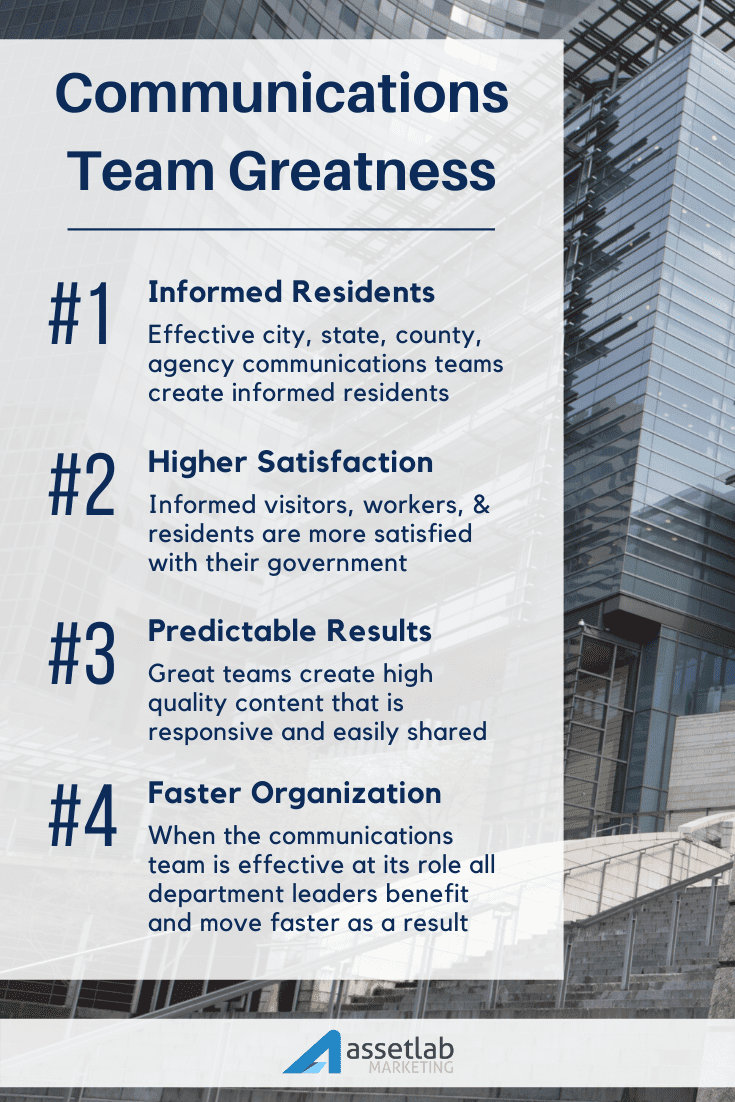During challenging times it is vitally important that cities, counties, states, and other government agencies effectively communicate with the residents they serve. Coronavirus and it’s many economic and social interaction consequences represents just such a time. This article provides specific guidance for City / County / State Public Information Officers, Communications Department Leaders, and Communications Staff explainin their role and best practices for using todays’ communications tools for greater efficiency.
Purpose Of The Communications Department During Challenging Times
Communications teams at cities, counties, states, and other agencies exist to achieve the following:
- Relieve the burden of communications and public relations from the Mayor, Executive, or Leader and their direct reports (typically Department Heads)
- Achieve predictable communications related results (branding, editing, scheduling, engagement on incoming issues on social media, creating a forward-looking content pipeline, leverage content on multiple channels, leverage multiple department communication assets)
- Improve resident, worker, and visitor satisfaction with the city or agency (multi-language, clear information flow on multiple channels, timely information)
- Create more informed residents (through growing communication channels on social media followers and email newsletter subscribers, TV channel viewers, print publication readers)
These four areas should be represented in the mission of the communications department and listed as S.M.A.R.T. Goals in the job expectations and performance goals for the Public Information Officer, Communications Department Head, or Leader.
Communications Team Responsibilities
- Consistency of messaging across channels
- Clarity of messaging across channels
- Public relations
- Press relations
- Internal staff communication
- Information sharing to residents through publications
- Branding
- Social media (and follower interaction)
- Website
- Television station scheduling & some show production
- Photography & Videography city-wide
Great Examples To Follow
If you’re looking to model agencies that are doing great at communicating to residents, visitors, and workers, here are some examples your team should replicate:
Communications Team Organization
There are two typical models for communications teams.
- Model #1, typically found at larger agencies, is a core communications team reporting to the Executive that works directly with Public Information Officers in each department reporting to the Executive.
- Model #2, typically found at smaller agencies, is a fully centralized communications team that reports to the Executive and is shared across all departments.
Typical communications teams roles are:
- Chief Communications Officer
- Video Programming and Production Manager
- Public Relations Specialist
- Community Engagement Lead
- Social Engagement Lead
- Digital Engagement Lead
- Graphic Designer
- Videographer & Photographer
- Public Information Officers
Communications Channels
The following is a simple communications plan by channel:
- Website is the detail-rich long format channel: Informational posts and articles as needed which are shared via other platforms
- Facebook is the “some of everything channel”: 1-3 posts/day
- Instagram is the channel for visual beauty & entertainment: 1 post/day
- Twitter is the official news feed: 1-5 posts/day
- Nextdoor is like Facebook: 1-2 posts per day
- Resident email list is the detail-rich blended channel: 1x/week (More often if the level of change is extreme and information discemination is critical)
- Press email list is for submission of important releases to the media and should be consisent with Website articles & Twitter: As needed
- City Radio: as needed
- City TV: as needed
Communications teams are the front line in informing residents, visitors, and workers during times of rapid change. A well working team relieves the communications and public relations burden from the agency it serves. During times of great change or challenge a well functioning communications department at the city, county, state, or agency level can make the difficulty of the situation far easier to adjust to for everyone involved.



